Friday, September 25th 2020
RTX 3080 Crash to Desktop Problems Likely Connected to AIB-Designed Capacitor Choice
Igor's Lab has posted an interesting investigative article where he advances a possible reason for the recent crash to desktop problems for RTX 3080 owners. For one, Igor mentions how the launch timings were much tighter than usual, with NVIDIA AIB partners having much less time than would be adequate to prepare and thoroughly test their designs. One of the reasons this apparently happened was that NVIDIA released the compatible driver stack much later than usual for AIB partners; this meant that their actual testing and QA for produced RTX 3080 graphics cards was mostly limited to power on and voltage stability testing, other than actual gaming/graphics workload testing, which might have allowed for some less-than-stellar chip samples to be employed on some of the companies' OC products (which, with higher operating frequencies and consequent broadband frequency mixtures, hit the apparent 2 GHz frequency wall that produces the crash to desktop).
Another reason for this, according to Igor, is the actual "reference board" PG132 design, which is used as a reference, "Base Design" for partners to architecture their custom cards around. The thing here is that apparently NVIDIA's BOM left open choices in terms of power cleanup and regulation in the mounted capacitors. The Base Design features six mandatory capacitors for filtering high frequencies on the voltage rails (NVVDD and MSVDD). There are a number of choices for capacitors to be installed here, with varying levels of capability. POSCAPs (Conductive Polymer Tantalum Solid Capacitors) are generally worse than SP-CAPs (Conductive Polymer-Aluminium-Electrolytic-Capacitors) which are superseded in quality by MLCCs (Multilayer Ceramic Chip Capacitor, which have to be deployed in groups). Below is the circuitry arrangement employed below the BGA array where NVIDIA's GA-102 chip is seated, which corresponds to the central area on the back of the PCB.In the images below, you can see how NVIDIA and it's AIBs designed this regulator circuitry (NVIDIA Founders' Edition, MSI Gaming X, ZOTAC Trinity, and ASUS TUF Gaming OC in order, from our reviews' high resolution teardowns). NVIDIA in their Founders' Edition designs uses a hybrid capacitor deployment, with four SP-CAPs and two MLCC groups of 10 individual capacitors each in the center. MSI uses a single MLCC group in the central arrangement, with five SP-CAPs guaranteeing the rest of the cleanup duties. ZOTAC went the cheapest way (which may be one of the reasons their cards are also among the cheapest), with a six POSCAP design (which are worse than MLCCs, remember). ASUS, however, designed their TUF with six MLCC arrangements - there were no savings done in this power circuitry area.It's likely that the crash to desktop problems are related to both these issues - and this would also justify why some cards cease crashing when underclocked by 50-100 MHz, since at lower frequencies (and this will generally lead boost frequencies to stay below the 2 GHz mark) there is lesser broadband frequency mixture happening, which means POSCAP solutions can do their job - even if just barely.
Source:
Igor's Lab
Another reason for this, according to Igor, is the actual "reference board" PG132 design, which is used as a reference, "Base Design" for partners to architecture their custom cards around. The thing here is that apparently NVIDIA's BOM left open choices in terms of power cleanup and regulation in the mounted capacitors. The Base Design features six mandatory capacitors for filtering high frequencies on the voltage rails (NVVDD and MSVDD). There are a number of choices for capacitors to be installed here, with varying levels of capability. POSCAPs (Conductive Polymer Tantalum Solid Capacitors) are generally worse than SP-CAPs (Conductive Polymer-Aluminium-Electrolytic-Capacitors) which are superseded in quality by MLCCs (Multilayer Ceramic Chip Capacitor, which have to be deployed in groups). Below is the circuitry arrangement employed below the BGA array where NVIDIA's GA-102 chip is seated, which corresponds to the central area on the back of the PCB.In the images below, you can see how NVIDIA and it's AIBs designed this regulator circuitry (NVIDIA Founders' Edition, MSI Gaming X, ZOTAC Trinity, and ASUS TUF Gaming OC in order, from our reviews' high resolution teardowns). NVIDIA in their Founders' Edition designs uses a hybrid capacitor deployment, with four SP-CAPs and two MLCC groups of 10 individual capacitors each in the center. MSI uses a single MLCC group in the central arrangement, with five SP-CAPs guaranteeing the rest of the cleanup duties. ZOTAC went the cheapest way (which may be one of the reasons their cards are also among the cheapest), with a six POSCAP design (which are worse than MLCCs, remember). ASUS, however, designed their TUF with six MLCC arrangements - there were no savings done in this power circuitry area.It's likely that the crash to desktop problems are related to both these issues - and this would also justify why some cards cease crashing when underclocked by 50-100 MHz, since at lower frequencies (and this will generally lead boost frequencies to stay below the 2 GHz mark) there is lesser broadband frequency mixture happening, which means POSCAP solutions can do their job - even if just barely.

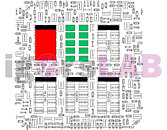
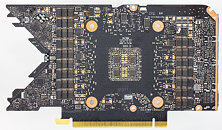
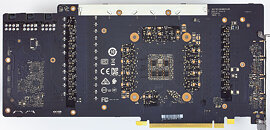
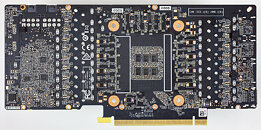
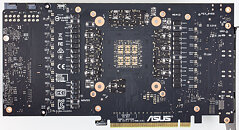
297 Comments on RTX 3080 Crash to Desktop Problems Likely Connected to AIB-Designed Capacitor Choice
Gigabyte's board starts with 6x POSCAPs / SP-CAPs... or whatever you wanna call the 470 uF big ones.
der8auer removed 2x 470uF, then replaced them with 20x 47uF MLCCs, achieving a +30MHz clock (0.03 GHz). So yes, it has an effect, but its quite minor.
I think its safe to say that this entire "capacitor" issue has been grossly overblown, based on the practical test from der8auer. The stock 6x 470uF caps were still able to hold a +70MHz overclock and was stable initially. But reaching +100MHz (+30MHz higher than before) with 20x MLCCs does show that there's some degree of benefit to the MLCCs, but nothing major.
I admit that der8auer did a 3090 test instead of the 3080, but I doubt that makes a major difference. The question is what's the effect of "6x Big Caps" vs "60x Small Caps", and that's what the video tests.
Well all this capacitors issue could also be alleviated when the die's power requirement does not change so rapidly, so I guess Nvidia introduced some clocks ramping hysteresis into the driver to improve stability. That doesn't mean Ampere will run at lower clocks like people would have thought though, just that the clocks would react slower, allowing some undershoot of the power target.
www.techpowerup.com/forums/threads/rtx3080-signal-pollution-demonstration-by-the-use-of-oscilloscope.272744/
Do you guys recommend I wait a few months before buying? Sounds like I should wait for these reported crashing issues to be ironed out first. I want to buy my GPU as quickly as possible but I also don't want to be a beta tester for something with known issues.
And welcome to TPU!
Gimped performance is more likely.
So after waying up the mediocre test provisioning Nvidia allowed AIB's with any driver, the rush then to get them out and the apparent ease with which Nvidia seam to have fixed the issues with a driver update, it's clear Nvidia are to blame.
No dramas just many an AIB GPU engineer can seek treatment from bus injuries now :):D.
In the meantime, I need to figure out what custom loop I'm going to go with. Never put together one of those before but I think my Lian Li O11 Dynamic is going to struggle to keep temperatures under control if I air cool it.Thanks! Happy to be here!
Good to see they kept the losses at an apparent minimum.
I downgraded my RAM from DDR4-4266 to DDR4-4000 19-25-25-45.
Then CTD disappeared even I OCed it to Pwr +117% and Core +55.